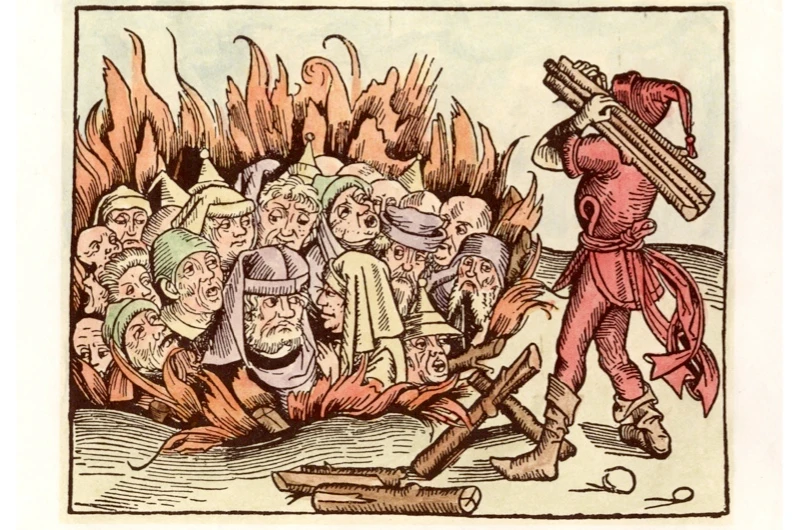I’ve recently been doing some reading on the Cathars, and it got me thinking about heresies. In the real world, heretical movements were a constant thing, and were subject of often ruthless suppression. Even in the earliest days of Christianity, there was a real struggle between the Catholic church and Arian Christianity; in fact, many Germanic tribes were first converted to the Arian brand of Christianity before being re-converted to the orthodoxy. It was a very real possibility that Arianism could have become the mainstream.
So here I present a few ideas for heresies that could crop up in a Greyhawk campaign. Such could be the start of adventures or even entire campaigns, and many offer up a change from the “same old” good vs. evil theme that is so often seen. Secret societies that were originally seen as sinister could end up being simply groups of such heretics that wish to keep their true beliefs and allegiances secret, and so forth.
The Church of the Harvester. An offshoot of the church of Nerull, this heretical sect acknowledges the necessity of the god of Death, and sees him as a necessary function of Nature’s plan. The sect is a mixture of those of Nerull and Istus, with Nerull being a close ally of the goddess of Fate, cutting the strands of fate that she spins on her spindle.
The Folk of Six. An inversion of the rival cults of Heironeous and Hextor, they believe that Hextor is in fact the good god who kills only to protect others, while Heironeous is the originator of slaughter and killing for its own sake. As such they are hated by both orthodox communities, and are persecuted by both.
The Gamblers. A small sect of Norebo-worshipers who believe that Istus, as goddess of Fate, is in fact subordinate to Norebo, the god of chance. Without such, they argue, then chance itself would not exist, as every action, even the tossing of dice, is preordained. The church of Istus sees this as a great heresy, while the orthodox church of Norebo avoids the argument entirely by saying Istus controls the fate of living creatures, but they are silent on whether her powers extend to inanimate objects.
The Legislativists. A breakaway sect from the church of Pholtus, they verge on being lawful evil, saying that the community is best served by laws that bolster the strong, rather than protect the weak. They argue that the weak will necessarily be protected if the strong are strengthened.
The Unitists. They believe that Lendor and Cyndor are in fact the same being, simply seen at different points in their own relative timeline. That is, Cyndor is a younger version of Lendor, and will eventually become the older, Greater god at some point, even though they can co-exist because of their mastery of time. The orthodox churches of both deities do not actively oppose this belief, but neither do they endorse it, as it doesn’t seem to have any practical impact, other than Unitist clerics and faithful mixing liturgies and using the names of the gods interchangeably in learned texts that are quite impenetrable to anyone not fully immersed in the complexities of time.










Incabulous the Replenisher
All things come to an end. They are returned to the Oerth where their decay replenishes the Oerth.
The Worm of Autumn rejuvenates.
Ye gods (pun intended), but I love the Unitist heresy! Makes the Lendor/Cyndor oddity comprehensible! Consider me a heretic!
In my recent delve into Suel mysticism I identified a number of “higher mysteries” which could result in heresies of various sorts. Certainly given their overlap in terms of spheres of influence, Fortubo and Jascar could easily be syncretized in some sects, though of course orthodox believers of either sect– particularly dwarves, would reject this; in the orthodox, Jascar is the lord of the mountains and hills, and Fortubo of that which lies beneath (with Beltar ruling the caves so deep that the geography of the surface they lie beneath becomes irrelevant).
A lot of the other heresies are particular to my campaign’s pantheology, which has Wee Jas and Kord as estranged spouses, and Norebo her new beau, so they probably don’t make sense to illustrate here.
Cool article.
I love the concept Joe, but I’d argue two points:
1) These kinds of schisms already exist in canon, with the Blinding Light, the One True Path and the Dark Light of Dimre, all of which worship Pholtus and all apparently get spells from him, for all that their doctrines are supposedly very different. One blog or video topic you might like to consider is how the same god, and a highly Lawful, doctrinaire one at that, can be granting spells to so many different sects.
2) History is rife with examples of conflict between real-life faiths, whether it be Sunni vs Shia in Islam, Catholic vs Protestant in Christianity, Conservative vs Reform in Judaism, etc. I don’t see any reason why fantasy game faiths would be any different, especially when you throw alignment into the mix.
In the case of St. Cuthbert, I can see different branches of its clergy arguing over whether to adhere to the laws laid down by whichever state they’re operating in, or to adhere to broader moral principles that might put them in conflict with the secular rulers of places like Greyhawk. Trithereonites might be divided over how individual rights mesh with the concept of community. Zilchans can argue over whether to support the slave trade.
NPC theologians could exchange long, heated correspondence or have loud vocal debates over these matters in the manner of Thomas Aquinas, Peter Abeldard or Martin Luther. This kind of diversity could also give background or adventure ideas for PCs who have clerical backgrounds, or even just background dressing.